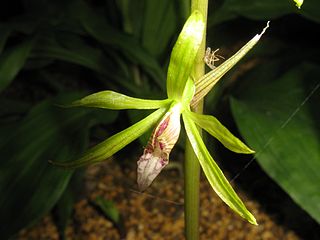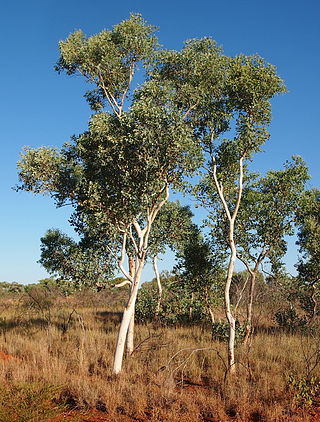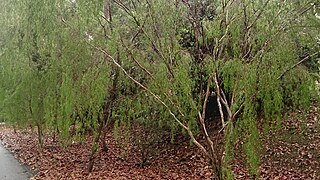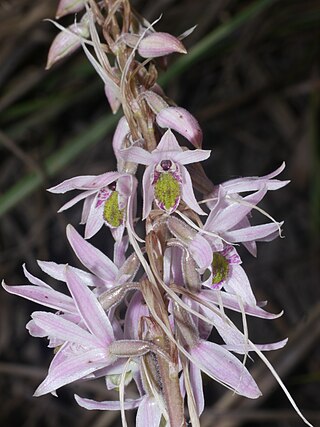
Leptospermum is a genus of shrubs and small trees in the myrtle family Myrtaceae commonly known as tea trees, although this name is sometimes also used for some species of Melaleuca. Most species are endemic to Australia, with the greatest diversity in the south of the continent, but some are native to other parts of the world, including New Zealand and Southeast Asia. Leptospermums all have five conspicuous petals and five groups of stamens which alternate with the petals. There is a single style in the centre of the flower and the fruit is a woody capsule.
Spathiostemon is a genus of trees in the Euphorbiaceae family. It is native to the Bismarck Archipelago, New Guinea, Wallacea and Southeast Asia. The trees grow between 10 and 20m tall, often in secondary forest. The wood is sometimes used.

Daphniphyllum is the sole genus in the flowering plant family Daphniphyllaceae and was described as a genus in 1826. The genus includes evergreen shrubs and trees mainly native to east and southeast Asia, but also found in the Indian Subcontinent and New Guinea.

Leptospermum petersonii, commonly known as lemon-scented teatree, is a species of shrub or small tree that is endemic to eastern Australia. It has thin, fibrous or flaky bark, often strongly-scented elliptic to lance-shaped leaves, white flowers and fruit that are retained for several years. It is commonly grown as an ornamental and is regarded as a minor environmental weed in some areas.

Acriopsis javanica is a species of orchid that is native to Southeast Asia, New Guinea, some Pacific islands and northern Australia. It is a clump-forming epiphyte with dark green leaves and curved, branching flower stems with many white and cream-coloured flowers with purple markings.

Spathoglottis plicata, commonly known as the Philippine ground orchid, or large purple orchid is an evergreen, terrestrial plant with crowded pseudobulbs, three or four large, pleated leaves and up to forty resupinate, pink to purple flowers. It is found from tropical and subtropical Asia to Australia and the western Pacific including Tonga and Samoa.

Nervilia concolor, commonly known as tall shield orchid, and to as Nervilia aragoana in Australia, is a small terrestrial orchid found in South Asia and Southeast Asia and in the northern regions of Australia. It has pale green, short-lived flowers with a cream-colored or yellowish labellum and a more or less circular leaf that emerges at the base of the flowering stem after flowering.

Eucalyptus alba, commonly known as white gum, khaki gum or poplar gum, is a species of tree that is native to Australia, Timor, and New Guinea. It has smooth bark, lance-shaped to egg-shaped leaves, flower buds in groups of seven, white flowers and conical to hemispherical fruits.
Lepionurus is a genus of plants in the family Opiliaceae described as a genus in 1826.

Leptospermum madidum is a species of shrub or small tree that is endemic to north-western Australia. It has weeping branches, smooth bark, pale green linear leaves, small white flowers and thin-walled fruit.

Goodyera rubicunda, commonly known as the giant jewel orchid, is a species of orchid that is native to parts of India, Asia, Southeast Asia, New Guinea, Queensland and some Pacific Islands where it grows in damp forest and rainforest. It has between three and six large, egg-shaped leaves and up to ten dull pink and white resupinate flowers that are hairy on the outside.

Pachychila pubescens, commonly known as pink kunai orchid or as 粉口兰 , is a plant in the orchid family. It is native to areas from Asia through Southeast Asia to New Guinea and northern Australia. It is a deciduous, terrestrial herb with one or two grass-like leaves and up to ten dull pink, more or less drooping flowers. It grows in wet, grassy places in forests and woodlands.
Dendrobium convexum, commonly known as the piggyback orchid, is an epiphytic orchid in the family Orchidaceae. It has a creeping, brittle root, erect pseudobulbs with a single leaf on the top and one or two cream-coloured, short-lived flowers with a red and yellow labellum. It is native to Southeast Asia, New Guinea and tropical North Queensland, Australia.

Schoenorchis micrantha, commonly known as the tangled flea orchid, is a small epiphytic orchid that forms small, tangled clumps and has thin stems, many linear leaves and up to thirty small, white, bell-shaped flowers. It is found from Indochina to the south-west Pacific.
Bryobium retusum, commonly known as Christmas Island urchin orchid, is an epiphytic clump-forming orchid that has oval, fleshy green pseudobulbs, each with two leaves and between seven and twelve short-lived, self-pollinating, pale green, hairy flowers. This orchid is found between Java and New Caledonia.
Thelasis capitata, commonly known as the conical fly orchid, is a plant in the orchid family. It is a clump-forming epiphyte with flattened pseudobulbs, each with a single strap-shaped leaf. A large number of small yellowish green flowers are arranged in a cone shape on a thin but stiff flowering stem. This orchid is found from Thailand to Malesia, including on Christmas Island.

Thelasis carinata, commonly known as the triangular fly orchid, is a plant in the orchid family. It is a clump-forming epiphyte or lithophyte that lacks pseudobulbs. There are groups of between two and six erect, flattened stems each with up to six leaves that have a ridged lower surface. Up to fifteen green and white flowers are arranged on a thin but stiff flowering stem. This orchid is found from Thailand to the southwest Pacific.
Leptospermum amboinense is a species of tree that is native to Malesia and North Queensland. It has rough bark, sessile, narrow elliptical leaves, white flowers and sessile, conical to hemispherical fruit.
Leptospermum pallidum is a species of spreading shrub that is endemic to Queensland. It has thin, firm, rough bark, narrow lance-shaped leaves, white flowers arranged in groups of two or three on side shoots and fruit that remains on the plant until it dies.
Spathiostemon javensis is a plant that can grow as a shrub or a tree in the tribe Acalypheae of the family Euphorbiaceae. It is native to the region from the Bismarck Archipelago to New Guinea, Wallacea and into Southeast Asia. It is often common in the understorey of forests. The wood is used in constructions.













